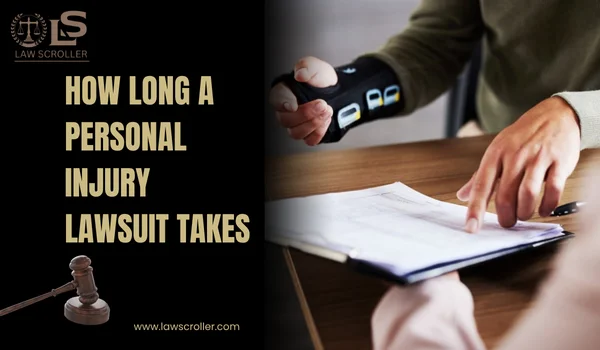If you’ve been injured due to someone else’s negligence, you might be considering a personal injury lawsuit. One of the first questions people ask is: How long will this take? Understanding the timeline helps you plan for medical treatment, work absences, and finances, and it gives you realistic expectations about when you might receive compensation.
Background: What is a personal injury lawsuit?
A personal injury lawsuit is a legal case filed by someone who suffered an injury because of another person’s negligence or intentional action.

- Plaintiff: The person who was injured and files the lawsuit.
- Defendant: The individual, company, or organization accused of causing the injury.
- Common cases: Car accidents, slip-and-fall incidents, medical malpractice, defective products, workplace injuries.
The goal is usually financial compensation to cover medical expenses, lost wages, pain and suffering, and property damage. Unlike class-action lawsuits, personal injury cases are mostly individual claims, and each case timeline can vary. (nolo.com)
Who’s affected — who can file a claim?
You may be eligible to file a personal injury lawsuit if:
- You were injured because of someone else’s negligence.
- Your injury caused physical, financial, or emotional harm.
- The injury occurred within your state’s statute of limitations (the legal time limit to file a claim). (findlaw.com)
People who generally cannot file include:
- Those whose injuries were not caused by someone else’s negligence.
- Those who missed the filing deadline (statute of limitations).
- Injuries caused entirely by the plaintiff’s own actions.
Essentially, anyone harmed by someone else’s preventable actions may consider filing a claim.
Timeline: How long does a personal injury lawsuit take?
The duration depends on the complexity of the case, severity of injuries, and willingness of the parties to settle. Here’s a typical timeline:
- Day 0: Injury occurs.
- Weeks 1–6: Seek medical attention, document injuries, and notify insurance if applicable.
- Weeks 2–12: Consult a personal injury attorney and evaluate your case.
- Months 1–6: Attorney gathers evidence: medical records, accident reports, photographs, and witness statements.
- Months 6–12: File the lawsuit (complaint) with the court.
- Months 12–18: Discovery process—both sides exchange evidence.
- Months 18–24: Settlement negotiations or mediation. Many cases settle at this stage.
- Months 24+: Trial (if no settlement) and verdict. Appeals may follow.
Simple estimates:
- Straightforward car accident or slip-and-fall: 6–12 months if settled quickly.
- Moderate complexity: 1–2 years, including discovery and negotiations.
- Complex cases (medical malpractice, severe injury, disputed liability): 2–4 years or longer.
What’s at stake
Financial compensation
- Medical expenses: Past and future treatment costs.
- Lost wages: Time off work due to injury.
- Pain and suffering: Physical and emotional distress.
- Property damage: Repairs or replacement (e.g., cars).
Health and quality of life
- Compensation can help cover rehabilitation, therapy, and ongoing care.
- A lawsuit may also encourage responsible parties to improve safety measures.
Factors affecting how long it takes
- Complexity of the case
- Multiple defendants, disputed liability, or serious injuries take longer.
- Evidence gathering
- Medical records, expert testimony, and accident reconstruction can extend timelines.
- Insurance negotiations
- If insurance companies resist paying or dispute liability, settlements may take months or years.
- Court backlog
- Local courts may have crowded dockets, delaying trial dates.
- Trial vs. settlement
- Most personal injury cases settle before trial, which shortens the timeline.
- Statutory deadlines
- Courts and laws set deadlines for filing motions, responses, and evidence submission.
What to watch next
- Settlement offers: Most cases are resolved through negotiation.
- Court dates: If no settlement, check your attorney for trial scheduling.
- Deadlines: Statute of limitations, discovery responses, and expert reports are critical.
- Medical updates: Ongoing treatment may affect compensation amounts.
- Appeals: If the verdict is contested, appeals can extend the case for months or years.
FAQs: Personal injury timeline basics
Am I eligible to file a personal injury lawsuit?
Yes, if someone else’s negligence caused your injury and you suffered harm, and you file within the statute of limitations.
Do I need a lawyer?
While not required, an experienced personal injury attorney can help navigate complex procedures and maximize compensation.
How long will my lawsuit take?
It depends on case complexity. Simple cases may settle in 6–12 months, while complex trials can last 2–4 years.
Can I settle without going to trial?
Yes. Most cases are resolved through settlement negotiations or mediation before trial.
What factors affect the timeline?
Case complexity, evidence gathering, insurance negotiations, court backlog, and whether the case goes to trial all play a role.
How can I speed up the process?
Promptly provide medical records, respond to attorney requests quickly, and cooperate with evidence collection. Settling outside of court usually speeds things up.
Knowing how long a personal injury lawsuit may take helps you plan financially and emotionally. While every case is unique, understanding the process gives you realistic expectations and helps you work with your attorney to get the best outcome.


 Oliver Johnson is LawScroller’s Senior Legal Correspondent specializing in civil litigation, class actions, and consumer lawsuit coverage. He breaks down complex settlements and court decisions into clear, practical guidance for readers.
Oliver Johnson is LawScroller’s Senior Legal Correspondent specializing in civil litigation, class actions, and consumer lawsuit coverage. He breaks down complex settlements and court decisions into clear, practical guidance for readers.